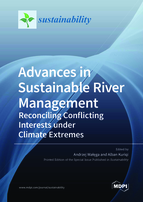Advances in Sustainable River Management: Reconciling Conflicting Interests under Climate Extremes
A special issue of Sustainability (ISSN 2071-1050). This special issue belongs to the section "Sustainable Water Management".
Deadline for manuscript submissions: closed (26 March 2023) | Viewed by 34497
Special Issue Editors
Interests: hydrology; water management; urban water management; climate change
Special Issues, Collections and Topics in MDPI journals
Interests: climate change; water resources management; floods; droughts; hydraulic structures; river restoration; ecohydrology; ecohydraulics; renewable energy; hydropower impacts
Special Issues, Collections and Topics in MDPI journals
Special Issue Information
Dear Colleagues,
Ever-increasing water exploitation mainly for water supply, irrigation and renewable energy have intensively degraded freshwater ecosystems, notably rivers. Further, the climate extremes and water scarcity enhanced by climate change induce additional stress in the freshwater ecosystems and may stimulate conflicts among water users. Therefore, assurance of optimal living conditions for aquatic organisms is one of the most important principles related to sustainable water management. Conservation and wellbeing of freshwater ecosystems are closely linked to the preservation of the natural hydrological regime. On the other side, human activities often alter not only the natural hydrologic regime but also habitat conditions for the aquatic ecosystem by substantially affecting several essential life-stages of aquatic organisms such as migration and spawning of fish, macroinvertebrates and other aquatic species. The problem is with the hydraulics structures (e.g., hydropower plants, dams, water intakes) within the catchments, planned or existing one, that may adversely affect the living conditions of aquatic organisms.
Also, we are aware that water is needed for several vital humans' activities, where agricultural and industrial seems to be the primary water consumer. In a situation where on the World are observed more frequent drought and water scarcity, water systems management requires the most advanced approaches and tools for rigorously addressing all the dimensions involved in the sustainability of its development. Therefore, the main objective of this Special Issue is to contribute in understanding and provide science-based knowledge, new ideas/approaches and solutions in sustainable river management, to improve water management policies and practices following different environmental requirements aspects.
In a broad view, interesting topics include but not limited to human impact on freshwater ecosystem with regards to climate extremes/change projections, successful practices in water supply and irrigation management, optimization of hydraulic structures to increase their efficiency and eco-sustainability, fish protection by implementing fish-friendly solutions (i.e., fish-friendly turbines and fishways), the optimization of hydropower schemes to reduce ecological impacts, environmental flows implementation, environmental assessments of hydropower plants and other water structures. Special attention will be given to those contributions that consider trade-offs and/or integration between some of the aspects/disciplines that drive the sustainability of water systems in the context of their development and management. In particular, the following topics are of high interest:
- Sustainable renewable energy (hydropower, energy mix)
- Irrigation
- Water supply
- Water structures
- Heuristic methods in water management optimization
- Water management under climate extremes/change
- Ecosystem preservation
- Environmental flows implementation
- Habitat modelling
- River restoration
- Hydrologic alteration
- Eco-friendly solutions
Dr. Andrzej Wałęga
Dr. Alban Kuriqi
Guest Editors
Manuscript Submission Information
Manuscripts should be submitted online at www.mdpi.com by registering and logging in to this website. Once you are registered, click here to go to the submission form. Manuscripts can be submitted until the deadline. All submissions that pass pre-check are peer-reviewed. Accepted papers will be published continuously in the journal (as soon as accepted) and will be listed together on the special issue website. Research articles, review articles as well as short communications are invited. For planned papers, a title and short abstract (about 100 words) can be sent to the Editorial Office for announcement on this website.
Submitted manuscripts should not have been published previously, nor be under consideration for publication elsewhere (except conference proceedings papers). All manuscripts are thoroughly refereed through a single-blind peer-review process. A guide for authors and other relevant information for submission of manuscripts is available on the Instructions for Authors page. Sustainability is an international peer-reviewed open access semimonthly journal published by MDPI.
Please visit the Instructions for Authors page before submitting a manuscript. The Article Processing Charge (APC) for publication in this open access journal is 2400 CHF (Swiss Francs). Submitted papers should be well formatted and use good English. Authors may use MDPI's English editing service prior to publication or during author revisions.
Keywords
- E-flows
- Indicators of hydrological alteration
- Renewable energy
- Water management optimization and modelling
- Habitat modelling
- Ecohydrology
- Ecohydraulic
- Hydropower
- Water quality
- Geomorphology
- Climate change
- Socio-hydrology
- Irrigation







